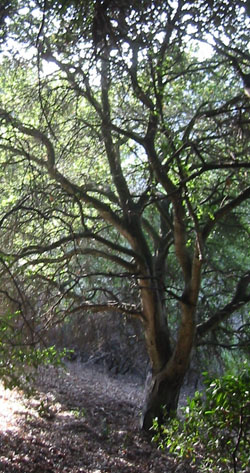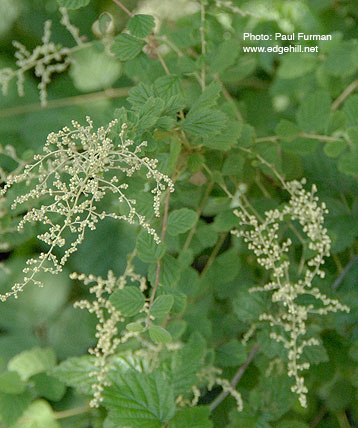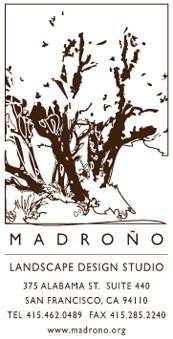 On a
mountain range in Oakland, a lioness prowls her historic canyon.
Rugged ridges and riotous riparian zones cleave the oak woodlands
and chaparral into complementary halves. This is the intersection
of sunlight and shadow,
of wilderness and the urban, of knowledge and the unknown.
On a
mountain range in Oakland, a lioness prowls her historic canyon.
Rugged ridges and riotous riparian zones cleave the oak woodlands
and chaparral into complementary halves. This is the intersection
of sunlight and shadow,
of wilderness and the urban, of knowledge and the unknown.
Leona Canyon Regional Open Space Preserve lies between Merritt College and the housing developments on Keller Avenue, a tether to natural history hemmed in by roads on all sides. Spared from the bulldozers by a land deal between builders and the East Bay Regional Park District in 1979, these 271 acres harbor diverse communities of native plants and sustain heritage populations of bees, butterflies, birds, and beasts of the field.
True, today the large mammals here are mostly joggers and off-leash dogs. But a hike on the 1.3-mile Leona Trail still feels like deliverance from the streets, a time warp back to the original trees that gave their lives and their name to the city. Amid the development of surrounding Alameda County, from which vehicle traffic now encircles the canyon, this slice of the lost wilderness yet lives.
Some sunny September morning, leave your car in the parking lot on Canyon Oaks Drive and walk west into Leona Canyon. Below and to your left, the flood plain of the creek has run nearly dry -- no rain in the past several months, after all. But the robust willow and hazelnut trees prove that water still flows here, even if only underground in the dry season. Climb farther into the canyon, where the water becomes more abundant, and soon you'll hear its voice babbling from the undergrowth.
As the trail ascends, the rising sun at your back sends a long shadow before you on the path. You now see compass points appearing on the landscape: two different plant communities on either side of the stream.
On your right, the dry, south-facing slope of the canyon lies exposed to the elements, a sun-blasted terrain of scrub oak, chamise, coyote brush, toyon, monkeyflower and poison oak. The Spanish called this "chaparral" after their name for the scrub oak Quercus berberidifolia, an ornery shrub with sharp-toothed leaves that render passage difficult if not painful. Imagine those explorers and conquistadors of the 18th century negotiating this impassable reddish-brown tangle on horseback, and you'll understand the origin of chaps - - both the garment and the word itself.
On your left, the cool north-facing slope of the canyon is a deep green forest of coast and interior live oak, tanbark oak, madrone, buckeye and bay, with a sprawling understory of ferns, California blackberry, thimbleberry and ocean spray. Because the sun's daily route passes behind this slope, the soil retains more water and the plants get more protection, rendering the landscape lush.
Such bifurcation of habitat illustrates the holistic adaptability of nature. The green vs. brown on the north- and south-facing slopes serve to complement one another, like puzzle pieces constituting something greater than the whole. It is a competitive, symbiotic paradox dictated by darkness and light, water and drought.
Between these two pages of the picture book, growing in the middle along the stream bed, the velvet leaves of hazelnut (Corylus cornuta var. californica) catch filtered sunlight and glow. The branches seem to grow outward as much as upward, with leaves held impossibly horizontal as if by a trick of levitation. The hazelnut fruit is edible, a gustatory bonus atop the aesthetic appeal of these stunning deciduous trees, which should be considered for any shady garden or irrigated native landscape.
 Ocean spray (Holodiscus discolor), a shrub of 4 to 20 feet,
also wins horticultural hearts with its leaves shaped like
delicate seashells and a frothy springtime bloom of dense
white panicles; it thrives here in
the riparian zone. By now the bloom has faded, and the
dried-up remains of the flower heads look rather dowdy in the fall,
but savvy home gardeners
keep this plant looking fresh by deadheading, while true
admirers
recognize those brown seedpods as the result of a lifecycle
well lived.
Ocean spray (Holodiscus discolor), a shrub of 4 to 20 feet,
also wins horticultural hearts with its leaves shaped like
delicate seashells and a frothy springtime bloom of dense
white panicles; it thrives here in
the riparian zone. By now the bloom has faded, and the
dried-up remains of the flower heads look rather dowdy in the fall,
but savvy home gardeners
keep this plant looking fresh by deadheading, while true
admirers
recognize those brown seedpods as the result of a lifecycle
well lived.
High upon an exposed knoll on the south face of the canyon,
the white fluffy seedpods of pipestems (Clematis lasiantha)
hang from the boughs of an oak like a 20-foot stole of
wool around the shoulders of a grand dame.
This woody vine climbs the surrounding vegetation and
flowers from
January to June, but the hairy bodies of its fruit keep
this plant interesting well
into the fall -- a fine choice for covering a fence,
especially on a hillside with good drainage.
Coming around a bend in the path, you encounter a grove
of buckeyes (Aesculus californica) whose leaves have
already fallen. These starbursts of gnarled denuded branches look
like an abstract
Expressionist painting
in coarse brushstrokes of gray and cafe au lait; closer
inspection reveals the coffee color as lichen growing
on the silver-gray
branches.
The phases of the buckeye signal the turning of the Earth from the sun just as surely as the pages of our calendars; this highly variable and prized element in the landscape (buckeyes can range from 15 to 50 feet tall) marks time with the clock hands of its deciduous branches: their candelabra blossoms of summer, chestnut-sized fruit of fall, naked siege of winter and the leafing out in spring with that thrilling whisper of green.
Unfortunately, many exotic invasive weeds have also put down roots here, and are spreading. There beside the stream, a snarl of periwinkle (Vinca major) covers an entire embankment; this notorious villain has escaped from horticulture and marauds by low-growing vinelike stems that root at the nodes. Here along the path, dense 15-foot-tall thickets of broom (species of Genista, Cytisus and Spartium) shade out the natives and produce hundreds of thousands of viable seeds per year, a reproductive prowess by which they have successfully infested a million acres or more in California.
Across the way, a blanket of Cape ivy (Delairea odorata), the rash interloper from South Africa, cavorts in the shadows and strangles trees, as it does in riparian regions throughout the state. These pest plants grow together in Leona Canyon with the native poison oak, an unfortunate partnership that discourages volunteer weed-pullers.
The word Leona comes to us from the Spanish for lioness, and this canyon may be named for a mountain lion encountered by a missionary some 200 years ago. You're not likely to find any big cats here today, but they surely roam in nearby Redwood Regional Park and around the Upper San Leandro Reservoir. Beautiful, proud, elusive, fierce and threatened: the lioness metaphor applies to all the natural world, which divides into day and night, city and forest, hunter and hunted, the serpent and its tail.
* * *
Writer, designer, and beast of the field Geoffrey Coffey thinks off-leash dogs and native plants are not mutually exclusive. He is the founder of Madroño landscape design studio, a principal of Bay Natives nursery, and a freelance writer for the San Francisco Chronicle.

